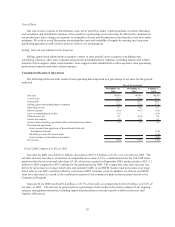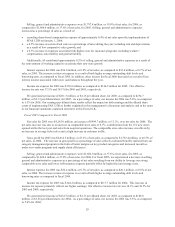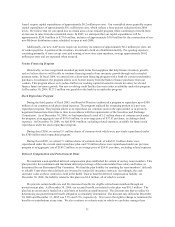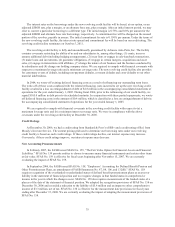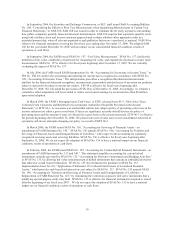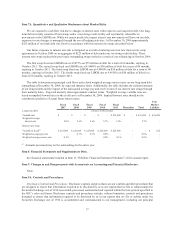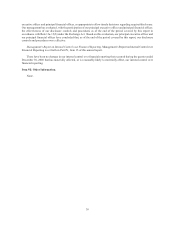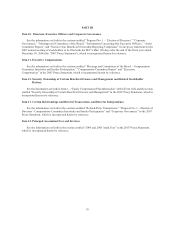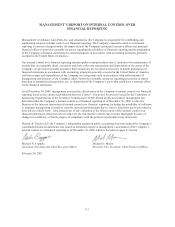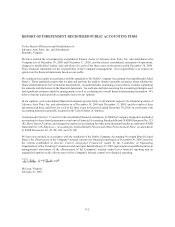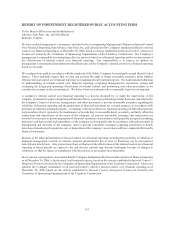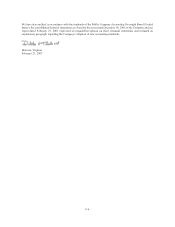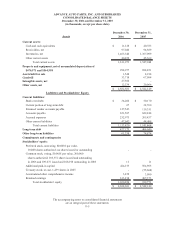Advance Auto Parts 2006 Annual Report Download - page 58
Download and view the complete annual report
Please find page 58 of the 2006 Advance Auto Parts annual report below. You can navigate through the pages in the report by either clicking on the pages listed below, or by using the keyword search tool below to find specific information within the annual report.The interest rates on the borrowings under the new revolving credit facility will be based, at our option, on an
adjusted LIBOR rate, plus a margin, or an alternate base rate, plus a margin. After an initial interest period, we may
elect to convert a particular borrowing to a different type. The initial margin is 0.75% and 0.0% per annum for the
adjusted LIBOR and alternate base rate borrowings, respectively. A commitment fee will be charged on the unused
portion of the revolver, payable in arrears. The initial commitment fee rate is 0.150% per annum. Under the terms of
the new revolving credit facility, the interest rate spread and commitment fee will be based on our credit rating. The
revolving credit facility terminates on October 5, 2011.
The revolving credit facility is fully and unconditionally guaranteed by Advance Auto Parts, Inc. The facility
contains covenants restricting the ability of us and our subsidiaries to, among other things, (1) create, incur or
assume additional debt (including hedging arrangements), (2) incur liens or engage in sale-leaseback transactions,
(3) make loans and investments, (4) guarantee obligations, (5) engage in certain mergers, acquisitions and asset
sales, (6) engage in transactions with affiliates, (7) change the nature of our business and the business conducted by
its subsidiaries and (8) change our holding company status. We are required to comply with financial covenants with
respect to a maximum leverage ratio and a minimum coverage ratio. The new revolving credit facility also provides
for customary events of default, including non-payment defaults, covenant defaults and cross-defaults to our other
material indebtedness.
In 2004, we wrote-off existing deferred financing costs as a result of refinancing our outstanding term loans.
The write-off of these costs combined with the related refinancing costs incurred to set up the new revolving credit
facility resulted in a loss on extinguishment of debt of $2.8 million in the accompanying consolidated statements of
operations for the year ended January 1, 2005. During fiscal 2004, prior to the refinancing of our credit facility, we
repaid $105.0 million in debt prior to its scheduled maturity. In conjunction with these partial repayments, we wrote-
off deferred financing costs in the amount of $0.4 million, which is classified as a loss on extinguishment of debt in
the accompanying consolidated statement of operations for the year ended January 1, 2005.
We are required to comply with financial covenants in the revolving credit facility with respect to (a) a
maximum leverage ratio and (b) a minimum interest coverage ratio. We were in compliance with the above
covenants under the revolving credit facility at December 30, 2006.
Credit Ratings
At December 30, 2006, we had a credit rating from Standard & Poor’s of BB+ and a credit rating of Ba1 from
Moody’s Investor Service. The current pricing grid used to determine our borrowing rates under our revolving
credit facility is based on such credit ratings. If these credit ratings decline, our interest expense may increase.
Conversely, if these credit ratings improve, our interest expense may decrease.
New Accounting Pronouncements
In February 2007, the FASB issued SFAS No. 159, “The Fair Value Option for Financial Assets and Financial
Liabilities.” SFAS No. 159 permits entities to choose to measure many financial instruments and certain other items
at fair value. SFAS No. 159 is effective for fiscal years beginning after November 15, 2007. We are currently
evaluating the impact of SFAS No. 159.
In September 2006, the FASB issued SFAS No. 158, “Employers’ Accounting for Defined Benefit Pension and
Other Postretirement Plans, an amendment of FASB Statements No. 87, 88, 106, and 132(R).” SFAS No. 158
requires recognition of the overfunded or underfunded status of defined benefit postretirement plans as an asset or
liability in the statement of financial position and to recognize changes in that funded status in comprehensive
income in the year in which the changes occur. SFAS No. 158 also requires measurement of the funded status of a
plan as of the date of the statement of financial position. We adopted the recognition provisions of SFAS No. 158 on
December 30, 2006 and recorded a reduction to the liability of $5.4 million and an impact to other comprehensive
income of $3.3 million, net of tax. SFAS No. 158 is effective for the measurement date provisions for fiscal years
ending after December 15, 2008. We are currently evaluating the impact of adopting the measurement provisions of
SFAS No. 158.
35





